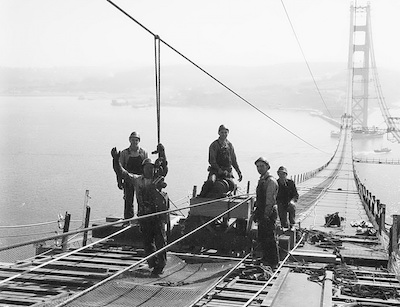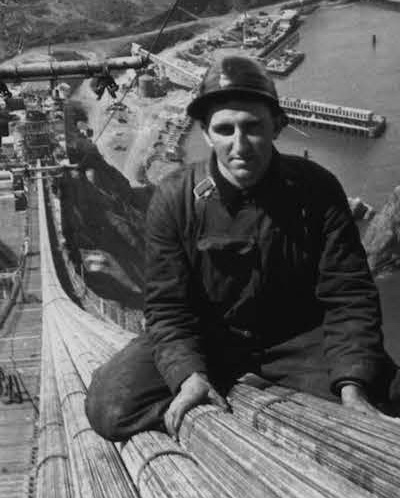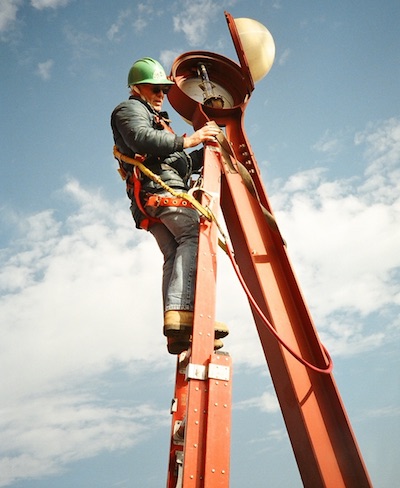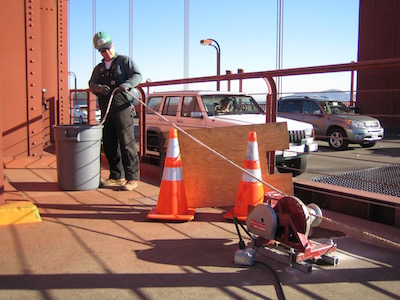“One day I heard they were going to start the Golden Gate Bridge, and I says well, I’ll try it. I never been up 746 feet but I’ll try it anyhow.”
That’s what IBEW member Fred Brusati told interviewer and historian Harvey Schwartz as part of an oral history project that is now a book by Schwartz titled, “Building the Golden Gate Bridge: A Workers’ Oral History.”
Much has been written about the Golden Gate Bridge, but much less has been said of the men – women were nonexistent on the project – who toiled hundreds of feet in the air over the Pacific ocean, dealing with massive fluctuations in weather conditions, as well as the dangers that came with construction in the 1930s – long before safety laws or OSHA. Now however, some of that record has been amended.
“Our brothers worked under perilous conditions to give us a beautiful structure that is still around today – that we still work on – and it is recognized the world over,” said Ninthth District Vice President John O’Rourke. “They deserve to have their voices heard.”
Brusati, then 76, and others who worked on the bridge sat down for interviews as part of an oral history project by the Labor Archives and Research Center at San Francisco State University. The interviews were conducted in 1987 and coincided with the 50th anniversary of the bridge’s completion.
Readers will hear the voices of immigrants, laborers, boxers and cowboys, as well as two of the nurses who cared for them when they were injured. Schwartz ends the book with two interviews with people currently working on the bridge.
“He captured those people, the way they talk. It was like being at work,” said retired Golden Gate Bridge employee and Local 6 member Allan Smorra of the book. “Those are my people.”
A Depression Era Project

|
| Harvey Shwartz’s new book captures the voices of the men who built the Golden Gate Bridge. Photo courtesy of Golden Gate Bridge, Highway & Transportation District.
|
Construction ran from 1933 to 1937, during the Great Depression when jobs were scarce. Without any state or federal funding, it would become the first suspension bridge built with a tower in the open ocean, said KQED, a public radio and television station, in a story for the 75th anniversary. At its time, it was also the longest suspension bridge in the world, with a length of 4,200 feet. The price tag was estimated at $35 million.
The bridge, one of the most recognizable in the world, spans the mile-wide Golden Gate Strait and connects San Francisco with Marin County to the north. It sits 220 feet above the water with towers reaching 746 feet. Its original combined weight totaled 894,500 tons, which included approximately 600,000 rivets in each tower.
Brusati and the others knew it was dangerous, but they needed the work – and they knew how coveted those perilous jobs were. Out-of-work men routinely lined the site, waiting for someone to quit or fall so they could get in.
”I’m … happy I had a job at that time because a lot of men weren’t working,” Brusati said. “Younger people nowadays can’t realize what a real depression is like. You didn’t have welfare or anything. It was really tough.”
The project was almost completely union so wages were generous, especially considering the economy, with a range of $4 to $11 per day, or $45 to $125 per day in 2004 dollars, said PBS in a feature story.
Brusati said he worked on the bridge as a member of Local 614 in Marin County (a Philadelphia local now holds the charter), just north of San Francisco. At the time, the local had only a handful of members. Later, during World War II, it would amalgamate briefly with San Francisco Local 6, then with Santa Rosa, Local 551, located about 60 miles north of the bridge. Brusati said he was still a member of Local 551 when he spoke with Schwartz.
“In late 1934 though, I was happy to get into Local 614. When I was at Hamilton Air Force Base around 1932, ’33, the unions weren’t very strong. Work was very scarce then too. But when we got on the bridge, you’d almost have to belong. You heard through the grapevine that a project like that was bound to be union. That’s when I decided, well I better join.”
Brusati also noted the union benefits of seniority and being on the book, something that was not as common in the 1930s. “Today [1987] in our union, IBEW Local 551, you have to go on the book, and whenever your turn comes up, they hire you. That was done so older members would get a chance to go to work. … Being on the book gives everybody a chance.”
A common theme in the interviews was the widely vacillating temperatures and weather conditions.
The Bay area is home to a number of microclimates that produce notoriously wide variations in temperature, winds and fog. So for the men working literally out in the ocean, hundreds of feet in the air, wild weather was inevitable.
Sometimes the men would stuff newspapers in their coats for extra warmth.
“What bothered me most about the job was that in San Rafael [about 12 miles north of San Francisco] it would be 70 or 80 degrees and sometimes on the bridge it was real cold …Then sometimes when it was clear it was hotter than blazes up on top. You’d get down to the bottom and you’d be almost freezing,” Brusati said.
Working so high up – a feat accomplished by riding in a tiny, rickety elevator – also meant that getting down took a long time, and lunch hours were 30 minutes. So they worked with what they had.
“Sometimes at lunchtime we would get a thousand-watt lamp and bring a little wire out there. A switch could go on and then we’d cook hot dogs. You put the wires in each end,” Brusati said. “I think the electricians figured that out on the bridge.”
Halfway to Hell Club

|
| IBEW member Fred Brusati, pictured, worked on construction of the Golden Gate Bridge, including on the most disastrous day when 10 men fell to their death. Photo courtesy of Labor Archives and Research Center, San Francisco State University.
|
In the days of the bridge construction, a good safety record was measured as one death per $1 million, wrote Schwartz. By this standard the Golden Gate Bridge was safe, especially when compared to the Bay Bridge, which was being built at the same time. Long before OSHA was established in 1971, the Golden Gate project mandated safety equipment rarely used then but now considered commonplace, like hard hats and safety nets.
“If you were caught on the catwalks without a hard hat on or without your safety belt on, they’d fire you,” Brusati said.
The hats were made by the E.D. Bullard Co. which had previously made hats for mining work. The hats worn by Brusati and the others were designed specifically for the bridge work, says GoldenGateBridge.org.
The safety net cost $130,000, said KQED, not a small sum in the 1930s. But it saved lives. Nineteen to be exact, who referred to themselves as the “Halfway to Hell Club” for the injuries suffered despite surviving the fall.
Unfortunately, not all lives could be saved. Eleven people died during construction, with 10 perishing on one fateful day, three months before completion. On Feb. 17, 1937, a platform broke from the bridge and tore the safety net, taking 10 men with it into the icy ocean water below. Brusati was there. He and a few others were able to save one man who had managed to hang on to a piece of steel.
“Me and three or four other men lowered a rope down and pulled him up. The man had a pipe in his mouth! He didn’t drop the pipe or nothing. He just started walking toward San Francisco. I never did see him back there again,” Brusati said.
For more on the incident, including Brother Brusati and others recounting that day, watch this video from the San Francisco State University Labor Archives and Research Center.
Keeping the Lights On
In his interview, Brusati noted how one day everyone was sent home except the electricians.
“One extra cold morning we went to work and heck, all the water lines were frozen. They sent everyone home but the electricians because we were more or less the firemen on the bridge in case of a fire.”
A lot has changed over the near 80 years since the bridge was completed, but some things remain the same, like IBEW members being central to its operation.

|
| While safety conditions since the days of the bridge’s construction have improved, working on the bridge is still not for the faint of heart. Photo courtesy of Allan Smorra.
|
“We’re one of the few who work on the bridge 24 hours a day, seven days a week,” O’Rourke said.
Local 6 has maintained the bridge since it was built. Today it’s a crew of eight who work in rotating shifts. Two of the eight actually come from neighboring a local in Dublin, Local 595. They are responsible for maintaining the toll collection system as well as the cameras, lights and other electrical aspects of the bridge and security system. They are also there in case the power goes out.
“We keep the bridge running,” said San Francisco Local 6 member and Golden Gate Bridge Foreman Jim McKnight. “We maintain everything electrical on the bridge, including the offices.”
Local 6 members are also in the process of replacing the roadway lights, switching them from high-pressure sodium to an inductive light that is more energy efficient and requires less maintenance.
Additionally, Local 6 built the server racks that power the computer and data systems. Members also put the security system on a fiber network and built the raceways that provide the power, things unheard of in Brusati’s day.
“If you had told me 20 years ago that I’d be working on computers on the bridge, I’d say you’ve got the wrong job,” McKnight said.
One thing that hasn’t changed though, is the weather.
“It gets so cold your hands freeze,” McKnight said. “The rule is, never go on the bridge without a jacket.”
Also, the height. At 746 feet, the towers are not for the faint of heart.
“People that don’t like heights, well, they can’t do it. Day two, they make you walk the cable [36 inches in diameter with a 12-inch, nonskid strip down the middle]. Basically, if you can’t walk the cable, then there’s no day three,” said Local 6 member Gregg Montarano in a video produced by the IBEW in 2011.
“When we change a lightbulb, it’s a major operation,” said Smorra, a 15-year veteran of the bridge.
The height and location of the bridge also cause it, a near 900,000-ton structure, to move.
“You’d think it’s so big it doesn’t move, but actually it’s so big it has to move,” Smorra said.
On a hot summer day, the bridge gets longer. Conversely, it gets shorter in the winter and at night when it’s colder. Smorra says that in the course of a day the bridge can rise five feet and drop 11.
“It feels alive,” Smorra said. “On a breezy day, there’s a hum, an aura.”
One day while changing a lamp, Smorra said the cable he was standing on started to vibrate. At that point, he was probably 700 feet above the water, and 400 feet above the road. The vibrations, he learned, were caused by a lumber truck down below. When heavy trucks like that cross the bridge they can hit the expansion joints which throws a longitudinal wave that causes the movement.
“It’s like grabbing a sheet and fluffing it,” Smorra said.
Another thing that has remained since the early days are the log books, which detail use of the fog lights, still operated manually, as well as traffic accidents and damaged equipment. The books also notes less mundane occurrences, like attempted suicides.
Most people who visit the bridge do so to get from point A to point B, or to marvel at the beauty and structure. Some however, go for more dire reasons. Since its opening, an estimated 1,600-2,100 people have jumped to their deaths, said SFist, a local publication.
“We’re all looking for someone in trouble,” McKnight said. “It’s not an official part of our job, but if we see someone who looks despondent, someone who is staring over the rails just hanging around, we’ll try to talk to them.”
When this does happen, McKnight or whoever is on shift calls the sergeant’s office. Everyone carries radios, and hotline phones and cameras are located along the bridge.
One night McKnight saw someone, staring out into the Pacific, standing alone.
“I just talked to him and said, ‘You look pretty cold, why don’t you come in and we’ll get some coffee.’ Fortunately he did. He didn’t stay for the coffee, but I was able to get him down and off the bridge.”
SFist reported that funding for a safety net has been approved by the Golden Gate Bridge, Highway and Transportation District and is expected to be in use by 2019.
Built by Labor

|
| Since its construction in the mid-1930s, the Golden Gate Bridge has been union built, including by IBEW members. Photo courtesy of Allan Smorra.
|
“One thing I’ll say is that the bridge was special because earlier nearly everybody said that it couldn’t be built,” said Brusati, who passed away in 1989 at the age of 78. “So after it all got built I said, ‘I guess everybody who figured this couldn’t be built must have been wrong. It’s all finished now and it’s going to stay up.’”
Stay up it has, thanks to the labor of electricians, ironworkers, painters, plumbers, operating engineers and other trades. And they’ve always had representation.
“It’s always been a union contract,” McKnight said.
Perhaps not unlike the improbability of building a massive suspension bridge in the world’s largest ocean, it’s a remarkable feat that the bridge was built by union labor when it was. When construction began in 1933, the Norris-La Guardia Act was only a year old. The act allowed for freedom of association and organization, but didn’t offer much federal protection for union organizing.
The National Labor Relations Act, or the Wagner Act, became law in 1935, two years into bridge construction. It came on the heels of a strike wave in 1933 and 1934 and encouraged collective bargaining as well as guaranteeing certain employee rights. It also created the National Labor Relations Board.
The epilogue to the book contains a quote from historian and author Kevin Starr, “An army cannot consist of officers alone, however talented; and a great bridge – while it owes so much to its designers and construction supervisors – owes an equal, if not superior, debt of gratitude to the workers who built it.”
Homepage photo credit: Wikimedia Commons